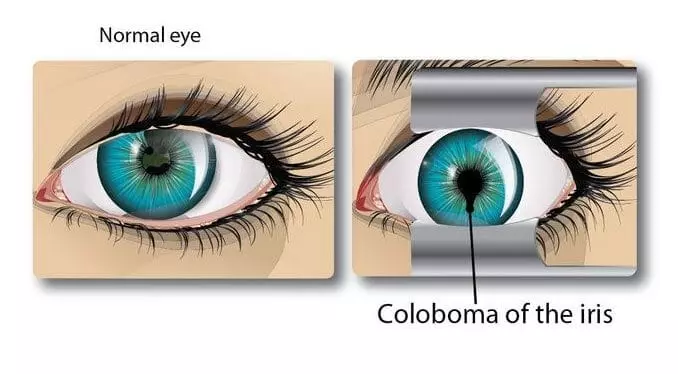People notice eyes. We find eye contact important in daily conversation and human connection, and eyes have always fascinated human beings. So, when a pair of eyes have a unique or vivid feature, we immediately take note of it. Bright blue irises can be mesmerizing, and hazel eyes can easily draw attention.
Usually, iris color is what sets one pair of eyes apart from another. But, occasionally, we may notice something different about another’s pupils.
There is one optical condition that can result in keyhole-shaped or cat-like pupils from birth. These changes in appearance are attributed to coloboma, which can affect the lens, iris, retina, or optic nerve. The eye disorder can also affect the eyelids, but is more common in the eye itself.
Here, we discuss what coloboma is, how it’s developed, how it can affect the eye, and what kind of treatment or observation is recommended.
Condition
Essentially, the term coloboma is used to describe the condition where a portion of tissue is completely missing from the eye or eyelid. If a person has coloboma of the eyelid, part of the eyelid may be absent, and if they have coloboma of the iris, they may have irregularly shaped pupils.
The word is derived from the Greek word “koloboma,” which means “curtailed” or “defect.” It is a defect of the eye that is actually developed in the womb, so an individual would have the condition for their entire life.
It’s a fairly rare condition, and most studies can’t seem to agree just how rare because there could be numerous individuals that haven’t been diagnosed. According to the collection of studies, coloboma can affect 0.5 to 2.2 people out of every 10,000.
Development
During the fourth week of pregnancy, a baby’s eyes begin to develop. The eyes essentially grow from the brain, starting out as simple stalks. Eventually, a major portion of these stalks becomes the optic nerves, and the ends of these stalks become the eyes.
Underneath these stalks, there’s a seam that runs from end to end named the optic fissure. At five weeks in the womb, this optic fissure starts to close, starting at the center of the seam. In rare cases, the optic fissure doesn’t completely close at the ends, resulting in coloboma of the eye.
If the fissure doesn’t close near the front, the baby can have coloboma of the iris or lens, and if the fissure doesn’t close near the back, they can have coloboma of the optic nerve or retina. However, it is possible to have more than one of these areas affected.
Cases of coloboma can be completely isolated, which means it isn’t a feature in a more extensive condition. It can happen unexpectedly with no real origin, or it can be passed on to children from parents through either recessive or dominant genes. Coloboma can also be a part of another condition, such as fetal alcohol syndrome or CHARGE syndrome.
Effect on Vision
Most of the time, coloboma is identified by the unusual shape of the iris, and an individual may not experience any issues with their vision or eyes at all. However, coloboma of the retina or optic nerve can impair a person’s vision, and the severity of the impairment can range from mild to serious. Coloboma can also result in a sensitivity to light.
Also, there are cases where coloboma will affect the individual’s vision, but the iris and lens are completely untouched. This can make it a bit harder to identify, but not impossible to diagnose.
While an individual has coloboma from birth, the disorder can cause other eye conditions later in life, including cataracts, microphthalmia, glaucoma, or retinal detachment.
Treatment and Observation
When a baby is discovered to have a coloboma, either by the hospital staff at birth or a parent, it’s best to have an ophthalmologist take a look and run a series of tests. While the ophthalmologist may be able to learn more about the baby’s issue, they can’t determine if the baby’s vision is impaired until a later age.
It’s recommended that tests are done regularly as the baby grows to check for vision impairment or other eye conditions. Children with coloboma under seven years old should get semiannual checkups, and children older than seven should have annual checkups. If an issue should develop, the ophthalmologist can catch it early and treat it accordingly.
Currently, there’s no way to completely repair or cure this disorder, but if an individual with coloboma of the iris is dissatisfied with their appearance, they can get cosmetic contacts to cover up the iris. In some cases, they may even be able to surgically repair the iris.
Coloboma is a fairly rare condition, but people can contract all kinds of eye conditions. If you’re having trouble seeing or are experiencing any other kind of eye discomfort, visit a local eye doctor, such as those at All About Eyes. We can take a look at your eyes, determine the problem, and discuss possible solutions with you.

